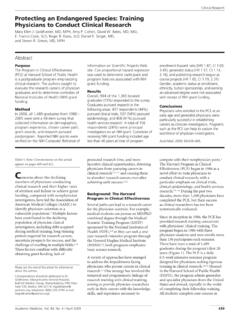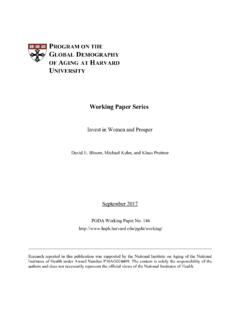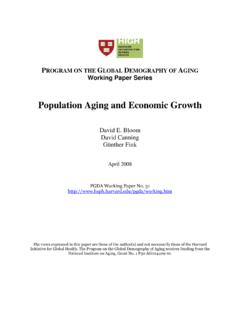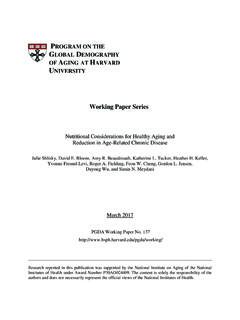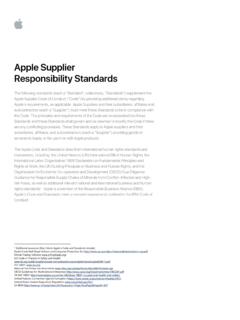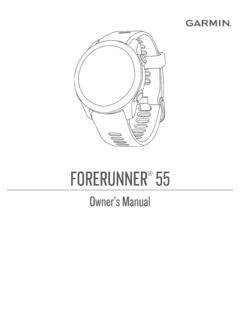Transcription of The Five Food Groups and Nutrition Facts - Harvard University
1 1session4 The Five FoodGroups andNutrition Facts (Note to the presenter: Comments in parentheses are instructions to followwhile giving the presentation. Do not read the comments to participants. Thisconvention will be followed throughout the notes in this slide show.)(Give give each participant a copy of this presentation, obtained by printingthe PDF version of these slides from the Training 2 folder on this CD-ROM.)This session focuses on the five food Groups and the best choices in eachgroup. It also introduces the Nutrition Facts food label in more Five food Groups Grains Vegetables Fruits Meat, fish, and beans Milk(Go over the five basic food Groups with participants: grains; vegetables;fruits; meat, fish, and beans [meat, poultry, fish, dry beans, eggs, nuts, andmeat alternatives]; and milk.)There are five basic food Groups : grains; vegetables; fruit; meat, fish, andbeans (meat, poultry, fish, dry beans, eggs, nuts, and meat alternatives); andmilk (which includes yogurt and cheese).
2 3 The Balanced Plate for Health(Distribute the Balanced Plate for Health handout from the AdditionalResources folder on this CD-ROM.)Each food group provides certain nutritional benefits, so foods from eachgroup should be consumed each key to a balanced diet is to recognize that grains (especially whole grains),vegetables and fruits are needed in greater proportion than foods from themeat, fish & beans and milk Groups . This principle is illustrated by theBalanced Plate for Health diagram that is used in several Eat Well & KeepMoving healthy and balanced diet also contains a variety of foods from within eachfood group , since each food offers different macronutrients (the energyproviding nutrients, namely carbohydrates, proteins, and fats) andmicronutrients (vitamins and minerals).Eating a variety of foods also keeps our meals interesting and full of that the Balanced Plate for Health does not contain sweets, foods that arehigh in saturated or trans fats, or foods that are low in nutrients.
3 These are"sometimes" foods, not everyday foods. Sometimes foods should be eaten inmoderation, and they are depicted on a small side let s move on to discussing each of the food Groups in a little : Make at Least Half ofYour Grains Whole Grains Grains contain carbohydrate, fiber, andsome vitamins and minerals. Whole grains are the healthiest choices. Choose foods that list a whole grain as thefirst ingredient and that are rich in fiber. Examples of whole-grain foods includewhole wheat bread, oatmeal, whole-graincrackers and breakfast cereals, whole wheatpasta, barley, brown rice, and plainpopcorn.(Distribute the food group Examples handout from the Additional Resourcesfolder on this CD-ROM. Distribute food labels from lesson 10 for SweetPotatoes [page 156 in the book], Plums [page 156 in the book], Chicken [page157 in the book], and Skim Milk [page 157 in the book]. Distribute any otherfood labels you have collected. Review the following information withparticipants:) Basic nutrients from the grains category are carbohydrate, fiber, and somevitamins and minerals.
4 In the grains group , the healthiest choices are whole grains, the less processedthe better. Whole grains contain fiber, vitamins, and minerals; the refiningprocess strips away many of these beneficial nutrients. Even though refinedgrains (such as white bread, white rice, and white pasta) are fortified withvitamins and minerals, fortification does not replace all of the lost nutrients. Choose foods that list a whole grain as the first ingredient. Examples of wholegrains include whole wheat bread, oatmeal, whole-grain crackers and breakfastcereals, whole wheat pasta, and other whole grains such as barley, brown rice,and plain popcorn. Look at the % Daily Value (% DV) for fiber on the Nutrition Facts label. The% Daily Value tells you whether a food is low or high in a nutrient. Whole-grain foods have a higher % DV for for 5 Fruits and Veggies More Is Better! Fruits and vegetables provide vitamins,minerals, and carbohydrate. Eat 5 or more servings of fruits andvegetables every day.
5 More is better! Choose fruits and vegetablesin a rainbow of and fruits provide vitamins, minerals, and carbohydrate. In generalthey promote overall good health. Eat 5 or more servings of vegetables andfruits every day; eating more is Good source of vitamins A and C, folate,iron, and magnesium Low in saturated and trans fat, high in fiber Choose a rainbow of colors, especially darkgreen and deep orange One serving = 1/2 cup cooked vegetables, 1cup of leafy salad greens, small glass of100% vegetable juiceVegetables ( , broccoli, spinach, and carrots) provide vitamins A and C andfolate as well as iron and magnesium. They are low in saturated and trans fatand high in vegetables in a rainbow of colors, especially dark green ( , broccoli,spinach, romaine lettuce, bok choy, kale) and orange ( , carrots, sweetpotatoes, winter squash).(Review the Sweet Potatoes Nutrition Facts label from page 156 in lesson 10of the book, and discuss serving sizes and nutrients.)
6 One serving of vegetables is 1/2 cup of cooked or raw vegetables, 1 cup of rawleafy vegetables, or a small glass of 100% vegetable Good source of vitamins A and C andpotassium Low in saturated and trans fat and high infiber Whole and sliced fruits have more fiber thanjuice and are better choices One serving = 1/2 cup chopped, cooked, orcanned fruit; 1 medium apple , banana, ororange; a small glass of 100% juiceFruits ( , oranges, cantaloupe, and strawberries) supply vitamins A and C aswell as potassium. They are also low in saturated and trans fat and high whole fruits or sliced fruits rather than fruit juices, since they containthe most fiber; if eating canned fruit, choose fruit canned in juice (rather thanfruit canned in syrup).(Review the Plums Nutrition Facts label from page 156 in lesson 10 of thebook, and discuss differences in serving sizes and nutrients.)One serving of fruit is 1 medium apple , banana, or orange; 1/2 cup chopped,cooked, or canned fruit; or a small glass of 100% fruit sure to limit your consumption of 100% fruit juice to no more than 8ounces per day; juice has vitamins and minerals, but it is naturally high in fruitsugar (fructose) and it lacks the fiber found in whole , Fish, and Beans Contain protein, B vitamins, and minerals Choose dry beans and peas, fish, poultry,nuts, and high-protein vegetarianalternatives more often than meat.
7 When eating meat, choose lean cuts. Removing skin from poultry reducessaturated in the meat, fish, and beans group supply protein, B vitamins, iron, andzinc. They are primarily responsible for building and repairing muscles andtissues, digesting nutrients, and improving immunity and blood dry beans and peas, fish, poultry, nuts, and high-protein vegetarianalternatives more often than meat; when eating meat, choose lean cuts; removethe skin from poultry to reduce saturated fat.(Review the Chicken Nutrition Facts label from page 157 in lesson 10 of thebook, and discuss nutrients.)9 Milk Good source of calcium; also containsprotein, riboflavin, and vitamins A and D Promotes strong bones and healthy teeth Choose plain low-fat (1%) or nonfat milk,yogurt, and other dairy foods. Calcium-fortified soy milk and rice milk arealternatives for people who do not products are the best sources of calcium. They supply protein, riboflavin,and vitamins A and D (if fortified).
8 This group helps promote strong bones andhealthy plain low-fat (1%) or nonfat milk, yogurt, and other dairy who cannot drink milk can choose lactose-free milk or calcium-fortified plain soy milk or rice milk.(Review the Skim Milk Nutrition Facts label from page 157 in lesson 10 of thebook, and discuss differences in nutrients.)10 Combination and Processed Foods Combination foods contain foods frommore than one food group . Processed foods are prepared andpackaged by foods contain foods from more than one food group ( , abrown rice and bean burrito with low-fat cheese: the tortilla and brown rice arein the grains group ; the beans are in the meat, fish, and beans group ; and thelow-fat cheese is in the milk group ).Processed foods are those prepared and packaged by manufacturers. Salt andother sodium-containing ingredients are often used in food Balanced Diet No single food supplies all needed nutrients. Choose foods from all the Groups each day.
9 Follow these guidelines to make the best choices: Eat 5 or more fruits and vegetables each day. Choose whole-grain foods and limit foods and beverages withadded sugar. Choose healthy fat, limit saturated fat, and avoid trans single food can supply all the nutrients needed to maintain good , not all foods in the same group contain the same nutrients. Oranges,for instance, do not contain much vitamin A, but cantaloupe is a good sourceof this foods from all the food Groups each day and choosing a variety offoods within each food group will help you meet your nutritional will also make your diet more make the best choices within each food group , remember the BalancedPlate for Health and these guidelines from the Principles of Healthy Living: Eat 5 or more servings of fruits and vegetables each day (especially eat dark-green and orange vegetables). Choose whole-grain foods and limit foods and beverages with added sugar. Choose healthy fat, limit saturated fat, and avoid trans Requirements Adults Women need 1,800 to 2,000 calories per day.
10 Men need 2,200 to 2,400 calories per day. Adults need more if they are very active. Children Girls aged 9 to 13 need 1,600 calories per day. Boys aged 9 to 13 need 1,800 calories per day. Children may need 400 calories more each day ifthey are moderately active. Very active boys and girls may need even planning a balanced diet, we must also keep in mind the energyrequirements for adults and women need 1,800 to 2,000 calories per day, and most men need 2,200 to2,400 calories per day; people need more if they are very aged 9 to 13 need about 1,600 calories per day, while boys aged 9 to 13need 1,800 calories per day; girls and boys who are moderately physicallyactive may need up to 2,000 calories per day (girls) and 2,200 calories per day(boys), and very active girls and boys (those who do the equivalent of walkingmore than 3 miles, or 5 kilometers, per day in addition to participating inregular daily activities) may need to consume even food LabelsThe Nutrition Facts food label is printed on nearly all packaged foods.
